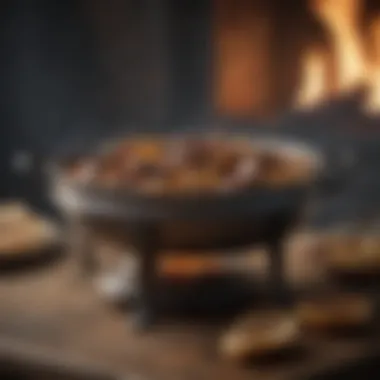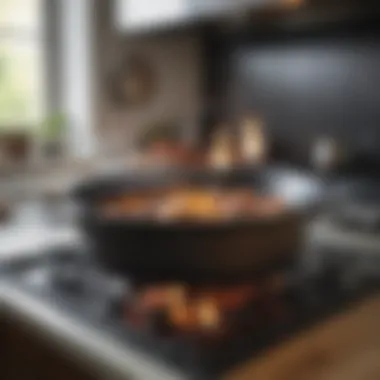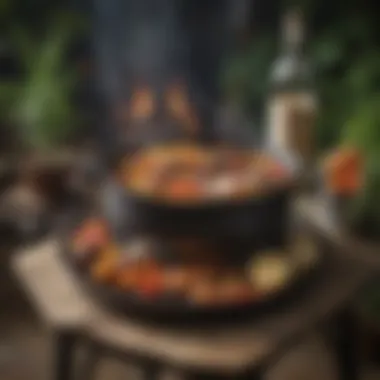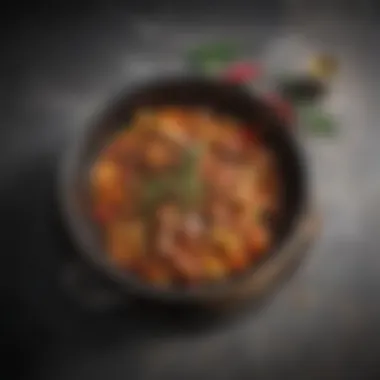Exploring the Complexities of the Brazier Pan


Intro
The brazier pan, a seemingly simple kitchen tool, carries with it a rich tapestry of history and tradition. It has served not just as a cooking vessel but also as a cultural bridge through different cuisines and culinary practices. The brazier pan, with its robust design, can elevate the process of cooking, bringing heat from various sources to prepare a diverse range of dishes. Its ability to retain heat makes it a favorite among both amateur cooks and professional chefs alike.
Today, we'll embark on a journey to uncover the layers of this fascinating tool. From exploring its historical roots to examining its contemporary relevance, we will dissect what makes the brazier pan a necessity in kitchens across the globe.
There’s much to unpack in our exploration, including the numerous types available, how to maintain them, and the myriad of delicious recipes one can create using them. So, whether you're a culinary novice or a seasoned expert, understanding the brazier pan unlocks a world of flavors and cooking techniques.
Prelims to the Brazier Pan
Brazier pans, often seen as the unsung heroes of the kitchen, hold a significant position in both culinary history and contemporary cooking. This introduction aims to lay down the groundwork for understanding the various facets of this versatile tool. Whether you are a seasoned chef or a novice cook, knowing the intricacies of the brazier pan can vastly enhance your cooking experience. Not only are they advantageous for cooking multiple types of dishes, but they also embody a cultural history that reflects the diverse cuisines across the globe.
Definition and Origin
The term "brazier pan" refers to a heavy-duty cooking pan primarily used for slow cooking and braising. Its origins can be traced back centuries, with ancient roots in various cultures that valued the art of slow-cooked meals. Historically, these pans were crafted from materials like cast iron or copper, known for their ability to retain and distribute heat evenly. The design of brazier pans has evolved, but their fundamental purpose has remained the same—to tenderize meats and meld flavors over extended cooking periods.
Attuning oneself to the characteristics of these pans is essential; be it their material composition or their suitable heating methods, understanding these elements will lead to better cooking outcomes.
Cultural Relevance
The cultural significance of brazier pans cannot be overstated. Across the globe, different cultures have embraced the use of these pans, from the French "cocotte" to the Japanese "nabe". Each variant showcases local ingredients and cooking styles, embodying rich traditions that date back generations. As societies evolved, so did the stories behind these tools.
For example, in Mediterranean countries, a brazier pan serves as an anchor for family gatherings, where slow-cooked stews are shared among friends and family. Alternatively, in Asian cultures, the equivalent of the brazier pan plays an integral role during communal meals, emphasizing the art of shared dining.
"In many ways, the brazier pan is more than just a cooking tool; it reflects the identity, traditions, and communal aspects of the cultures it belongs to."
Engaging with a brazier pan allows individuals to connect with both their culinary heritage and the broader world, fostering a deeper appreciation for global cooking practices. Through exploring its origins and cultural relevance, readers will gain insights into why the brazier pan has remained a cherished staple in kitchens worldwide.
Types of Brazier Pans
Understanding the types of brazier pans is essential for anyone looking to elevate their culinary skills. Each type offers unique characteristics that cater to various cooking styles, making them suitable for different preferences and needs. When choosing a brazier pan, factors such as material, design, and intended use become critical in determining which is best suited for your kitchen. Let's explore the various materials and design variations that define the world of brazier pans.
Materials Used
Cast Iron
Cast iron stands as a classic choice among enthusiasts for its impressive heat retention and distribution properties. One of the key characteristics of cast iron is its ability to withstand high temperatures, making it ideal for searing meat or browning vegetables. Its durability ensures that a well-cared-for cast iron pan can last generations, becoming more seasoned and flavorful over time.
However, it’s worth noting that cast iron can be quite heavy and may require specific care, like avoiding soap while cleaning to maintain its seasoning.
"A well-maintained cast iron pan is a treasure in any kitchen, transforming simple meals into culinary delights."
Aluminum
Aluminum offers a lightweight alternative to cast iron, prized for its excellent heat conductivity. This material heats up quickly, allowing for fast cooking and precision. The non-stick nature of some aluminum pans makes them convenient for preparing delicate dishes, like eggs or fish. With less cooking time needed, these pans are beneficial for those with busy lifestyles.
Nevertheless, aluminum is often less durable than cast iron and might warp under extreme heat. Additionally, some aluminum products may require seasoning or special coatings to prevent food from sticking.
Stainless Steel
Stainless steel is celebrated for its sleek appearance and non-reactive characteristics. It doesn’t retain flavors or odors, which makes it a great choice for cooking acidic dishes, such as tomato-based sauces. The resilience of stainless steel also means it can handle high heat without damaging the surface.
One drawback is that stainless steel pans may not provide the same level of heat distribution as cast iron, which can lead to uneven cooking if not managed correctly. Moreover, achieving a non-stick effect may require the use of oil or butter.
Clay


Clay pans bring a touch of traditional cooking to the table. Known for their natural insulation properties, clay retains moisture while allowing for slow, even cooking. This makes them ideal for hearty stews and braises. One unique feature of clay pans is their ability to impart a slight earthy flavor to dishes.
However, they often require careful handling as they can be more fragile than metal counterparts. Additionally, many clay pots need to be soaked before use to prevent cracking when heated.
Design Variations
Traditional Models
Traditional models of brazier pans often reflect the rich heritage of cooking practices. They tend to feature distinct shapes and sizes tailored to regional recipes. The time-tested designs of these models often prioritize functionality, allowing the cooks to adapt to specific heat sources, such as open flames or modern stoves.
While traditional models are beloved for their historical significance, they may lack the versatility of newer designs that cater to contemporary cooking methods.
Modern Innovations
Modern innovations in brazier pan design include features like multi-layer construction and non-stick surfaces that accommodate busy lifestyles. These innovations often prioritize ease of use, catering to a broader audience of cooking enthusiasts. Enhanced features, such as ergonomic handles and lighter materials, make them more accessible.
Yet, as enticing as these aspects are, some chefs might prefer the authenticity and craftsmanship of traditional pans.
Functional Uses
The brazier pan not only stands out in design and material but also plays a pivotal role in the culinary landscape. Understanding the functional uses of this pan is critical for enhancing your cooking adventures. From robust outdoor grilling to the gentle simmer of a stew, each technique reveals a different dimension of this versatile tool. The significance of these functional approaches lies not just in the cooking methods but in how they can elevate everyday food into something extraordinary.
Cooking Techniques
Grilling
Grilling in a brazier pan is a slice of culinary heaven. This technique, often associated with summer barbeques and outdoor gatherings, brings out the perfect char on meats and vegetables. The unique feature of grilling in this pan is its ability to retain heat evenly, creating those perfect grill marks while sealing in the juices. What's more, the porous surface of some brazier pans, especially those made with cast iron, heightens the flavors infused into the food.
The advantages of using a brazier pan for grilling are manifold. Firstly, its robust construction withstands high temperatures without warping. Secondly, unlike many traditional grilling methods that often lose flavor with overcooking, the brazier’s design allows for better heat retention and control. However, care must be taken to avoid excessive sticking if the pan isn’t well-seasoned.
Roasting
When it comes to roasting, the brazier pan proves itself as a stalwart companion in the kitchen. Roasting transforms basic ingredients into rich, flavorful dishes through dry heat. A key characteristic of roasting in a brazier pan is its depth, allowing for a generous amount of ingredients to be cooked at once while ensuring even browning.
This technique is particularly beneficial for creating hearty meals like a vegetable medley or a fragrant chicken roast. The additional depth can often lead to remarkable results where flavors meld beautifully. However, one must note that the pan's heavy weight might pose challenges for some in handling.
Simmering
Simmering is perhaps the most subtle yet rewarding way to utilize a brazier pan. The slow, gentle heat draws out the flavors of ingredients effectively, making it an exceptional choice for stocks, soups, and sauces. The distinct advantage of simmering in a brazier pan is its capacity to maintain a consistent temperature, preventing the food from boiling over or burning.
One of the unique features of this cooking technique is its forgiving nature. You can leave simmering dishes unattended for longer periods without worrying about them becoming overcooked, unlike more aggressive methods. However, one needs to mind the size of the pan, as the larger models may require significantly more liquid to achieve the desired results.
Brazier Pan in Outdoor Activities
Brazier pans shine in outdoor cooking settings as well. They enhance the experience of cooking under the sky, whether it's at campgrounds, picnics, or backyard barbecues. Their durability and ability to withstand open flames lend them even more appeal. Some outdoor enthusiasts find that the versatility allows for experimentation with different cooking methods, such as grilling over charcoal or even slow cooking over an open fire.
Using a brazier pan outdoors can create a communal appreciation of food, tying everyone back to basic culinary practices. The beauty of these moments lies in simplicity—a good meal shared with friends and family, often reflecting the energy of the environment. Thus, whether you're searing meat for a picnic or simmering a hearty soup over a fire, the brazier pan is both a functional and symbolic tool, reminding us of the joys of outdoor culinary exploration.
Care and Maintenance
Understanding how to properly care for and maintain a brazier pan is crucial for preserving its lifespan and ensuring optimal cooking performance. Like a trusty pair of shoes, if you don't take care of them, they won't last long. For the food enthusiast, this cooking tool deserves special attention not only for its functionality but also for the culinary memories it helps create.
Cleaning Techniques
Cleaning a brazier pan is a task that requires careful consideration. Unlike other cookware, the brazier pan’s materials dictate the cleaning method you should adopt. For instance, if you're dealing with cast iron, seasoned maintenance is key. First, while the pan is still warm (but not burning), wipe it down with a cloth to remove residues. Then, use a non-abrasive brush and hot water for stubborn scraps—but skip the soap! Soap can strip your pan of its essential seasoning layer.


For aluminum pans, the situation is a bit different. Mild soap can be used, along with a soft sponge. Avoid scouring pads as they could scratch the surface. It's best to rinse thoroughly and dry immediately to prevent spots and staining. With stainless steel, you can use a solution of vinegar and water to tackle tough grease. After scrubbing, rinse well and dry.
"Maintain your brazier pan like a fine watch; diligence pays off in longevity and performance."
Cleaning clay brazier pans, often used in traditional recipes, involves gentle handling. A soft sponge, water, and air drying are ideal to prevent cracking. In sum, regardless of the material, the aims remain the same: ensure cleanliness without compromising the integrity of the pan.
Storage Recommendations
An overlooked aspect in cookware upkeep is proper storage. For food lovers, knowing how to store a brazier pan can spell the difference between a versatile cooking tool and a neglected item gathering dust. Ideally, store your brazier pan in a dry area to avoid moisture buildup which can lead to rust, especially in cast iron versions.
Placing a paper towel or a soft cloth between stacked pans can help protect the surfaces from scratches. If you have a dutch oven or other heavy pots, it's wise to keep the brazier pan at the top in your cabinet or rack to avoid unnecessary weight on it.
Moreover, it's important to give some thought to where you place the pan — keeping it within arm's reach can make cooking less of a chore. As you think about your kitchen layout, remember that ready access can inspire culinary creativity.
When it comes to outdoor activities, ensure the pan is adequately sheltered from weather elements. Whether it’s a breezy picnic or a camping trip, optimal care while traveling can enhance the enjoyment of outdoor cooking. Ultimately, treating your brazier pan with respect during both use and storage resonates far beyond mere utility.
Brazier Pan Recipes
The brazier pan isn’t just a tool for heating or cooking; it’s a versatile companion in the kitchen that brings dishes to life. In this section, we dive into various tantalizing recipes suited for the brazier pan that highlight its unique characteristics. Cooking with a brazier pan allows for even heat distribution and enhances flavors. The recipes provided here cater to a wide array of tastes, ensuring that anyone can whip up something delicious.
Vegetarian Options
The beauty of the brazier pan shines brightly in vegetarian cooking. One such delightful recipe is the Mediterranean Ratatouille, which combines fresh vegetables like zucchini, eggplant, and bell peppers cooked slowly to let the flavors meld together. Just toss in a generous drizzle of olive oil, add some garlic, and let it simmer in the brazier pan until everything softens and the aroma fills your kitchen.
Another excellent choice is the Stuffed Bell Peppers. Using grains like quinoa or rice mixed with black beans, corn, and spices, fill the halved bell peppers and place them in the brazier pan with a bit of broth to steam and cook through. Not only does this dish look vibrant, but it’s also a wholesome meal packed with nutrients.
- Key Benefits of Vegetarian Recipes in a Brazier Pan:
- Flavor Enrichment: Slow cooking enhances the depth of flavors.
- Nutrient Retention: Cooking at a moderate temperature preserves essential nutrients and textures in vegetables.
Meat Dishes
The brazier pan is equally adept at preparing mouthwatering meat dishes. Imagine a Braised Short Rib, which requires just a simple sear and then a long, slow cook to transform the tough meat into a tender, flavorful delight. Simply brown the ribs, then add onions, carrots, and red wine. Allow it all to simmer partially covered until the meat pulls apart easily with a fork.
For a spicier option, consider Chili Con Carne. Brown ground beef or turkey in the brazier pan, and then add kidney beans, tomatoes, and a mix of spices. Let it simmer to blend the flavors—this one-pot meal is perfect for serving large families or gatherings.
- Meat Dish Considerations:
- Cooking Time: Meat should typically be cooked longer at low temperatures to develop rich flavors.
- Leftover Magic: One of the best things about meat dishes is that they often taste even better the next day.
Desserts and Sides
While many may overlook the brazier pan for sweets, it can certainly shine in preparing desserts. One standout is the Peach Cobbler. The unique heat distribution of the brazier allows the peaches to caramelize beautifully. Combine sliced peaches with sugar and vanilla, top with a crumbly mixture, and bake uncovered. The result is a sweet, bubbling delight that screams comfort.
On the side, Herb-Infused Rice benefits from the braising technique too. Cook the rice in the brazier pan with vegetable broth, adding herbs of your choice, like basil or thyme. As it cooks, the rice absorbs the flavors, turning out fluffy and fragrant, a perfect complement to any main dish.
- Important Tips for Desserts:
- Control the Heat: Always watch your sugar levels and heat to avoid burning.
- Layering Flavors: Use contrasting flavors (like tart and sweet) for depth in the final dish.
In summary, exploring recipes using a brazier pan opens up a treasure chest of culinary adventures. From vegetarian delights to hearty meat dishes, and even sweets, the brazier pan proves to be an indispensable asset in any kitchen.
Comparative Analysis with Other Cookware
Understanding the brazier pan in relation to other cooking tools is crucial for home chefs and culinary enthusiasts alike. Each piece of cookware has its strengths, and comparing the brazier pan to other options helps highlight where it excels and where it might not fit perfectly in one's cooking arsenal. This comparative analysis not only illuminates its unique attributes but also aids readers in making informed choices when investing in cookware.


Brazier vs. Dutch Oven
When putting the brazier pan side by side with the Dutch oven, a few fundamental differences come into play.
- Shape and Design:
- Cooking Method:
- Versatility:
- The brazier pan usually has a wider and shallower structure, allowing for even heat distribution and easier access to food for stirring or flipping. On the other hand, the Dutch oven is taller, with a more rounded shape, suitable for stews and braised dishes.
- Braisers are ideal for browning meats before slow cooking, ensuring flavor is locked in. A Dutch oven, with its thick walls, excels at slow cooking and simmering, where moisture retention is critical.
- While both types of cookware can handle a variety of tasks, the brazier is often favored for sautéing and pan-frying, whereas the Dutch oven shines in baking bread or cooking larger quantities of liquid-based dishes.
"A brazier pan brings dishes to life with a perfect sear, while a Dutch oven is your go-to for hearty stews that simmer for hours."
In summary, while both pans have their uses, the choice largely depends on the cooking style and the dish being prepared.
Brazier vs. Skillet
Next up, the comparison between the brazier pan and the skillet reveals even more interesting insights:
- Depth:
- Heat Distribution:
- Dish Variety:
- A typical skillet has shorter sides, which makes flipping pancakes or cooking eggs a breeze. In contrast, the brazier, with its higher edges, is better suited for larger cuts of meat and dishes where splatter might occur.
- The thicker base of a brazier pan allows it to hold heat longer, making it effective for slow cooking. A skillet, being thinner, heats up quickly but may not retain heat as effectively once off the burner.
- The brazier's ability to go from stovetop to oven makes it great for recipes needing both frying and baking. A skillet might struggle to retain heat during oven use, though some cast iron skillets can manage quite well.
The Future of the Brazier Pan
As cooking methods evolve and culinary creativity soars, the future of the brazier pan stands at a fascinating crossroads. It’s not just about preparing meals; it’s about how this versatile tool can adapt to changing tastes, practices, and even environmental considerations. The importance of understanding the future of the brazier pan lies in its potential to merge tradition with innovation. With each culinary revolution, the brazier pan can retain its place in kitchens, adjusting to the needs and preferences of both professional chefs and home cooks alike.
Trends in Cookware Design
The world of cookware design is rapidly transforming, influenced by a myriad of factors including consumer preferences, cooking technologies, and social trends. The brazier pan is no exception, finding itself at the heart of these changes.
- Multi-functional Designs: Many contemporary brazier pans are crafted to serve multiple purposes, from stovetop cooking to oven-baking and even serving. This is particularly appealing to those who prefer streamlined, adaptable kitchen tools.
- Smart Technology Integration: The rise of smart kitchens has introduced advanced features into cookware, allowing for temperature control and app connectivity. Imagine a brazier pan that alerts you when the food reaches the ideal cooking temperature or helps you track cooking times.
- Aesthetic Innovations: Aesthetics play a significant role in cookware selection. Today's brazier pans often come in a variety of vibrant colors and finishes, appealing to stylish culinary enthusiasts who value visual presentation.
These design trends not only enhance functionality but also support a modern lifestyle where efficiency and style go hand in hand. As consumer demands shape the industry, it ensures that the brazier pan remains relevant.
Sustainability in Cooking Practices
A considerable focus on sustainability is reshaping how cooking is approached, and the brazier pan is ideally positioned to make a positive impact. Here are some key considerations:
- Sustainable Materials: The move toward using environmentally friendly materials is gaining traction. Options like recycled metals or sustainably sourced clay are now common, paving a greener path for the brazier pan.
- Resource Efficiency: Cooking with a brazier pan can be more energy-efficient compared to other methods. Because braziers can maintain heat well, they often require less fuel and energy, particularly in long-cooked dishes.
- Minimizing Waste: The adaptability of brazier pans allows for one-pot meals, reducing the need for multiple cookware items. This not only saves space but also minimizes dishwashing and potential food waste.
Embracing sustainability within cooking practices ensures that the brazier pan not only continues to serve a culinary purpose but does so with ecological responsibility.
"The future of the brazier pan is about harmonizing culinary innovation with sustainability and design, ensuring it thrives amid changing preferences."
By keeping an eye on trends in cookware design and the sustainability movement, it’s clear that the brazier pan is not heading toward obsolescence; rather, it’s on a path of continual evolution. As it weaves through the fabric of modern cooking culture, it stands poised to embrace new challenges and opportunities, ensuring its place at the heart of both traditional and forward-looking kitchens.
Culmination
In this exploration of the brazier pan, we've journeyed through many layers of its significance in cooking and culinary history. The conclusion here is vital as it synthesizes the myriad points we’ve discussed throughout the article. Understanding the role of the brazier pan extends beyond just its physical attributes; it embodies a tradition that connects modern cooks with their culinary ancestors.
Summary of Key Points
- The brazier pan has a rich historical backdrop that accentuates its essential role in many kitchens.
- We examined various types of brazier pans, noting the materials and design innovations that suit diverse cooking styles.
- This pan performs remarkably in cooking techniques like grilling, roasting, and simmering, showcasing its versatility.
- Care and maintenance are simple yet crucial aspects, extending a brazier pan's lifespan and performance.
- Unique recipes ensure this tool is beyond functional; it can inspire culinary creativity in preparing dishes from entrees to desserts.
- Comparing the brazier pan with other cookware such as the Dutch oven and skillet illustrated its unique benefits and limitations.
- The trends we highlighted underscore a growing interest in sustainable practices and innovative designs in cookware.
Final Thoughts
As we digest the various threads of the brazier pan narrative, it’s clear that this culinary tool has much to offer. Whether you're a novice in the kitchen or a seasoned chef, understanding different cookware can enhance your culinary skills. The brazier pan stands as a bridge between traditional and contemporary cooking, merging past culinary practices with the present and future of gastronomy.







